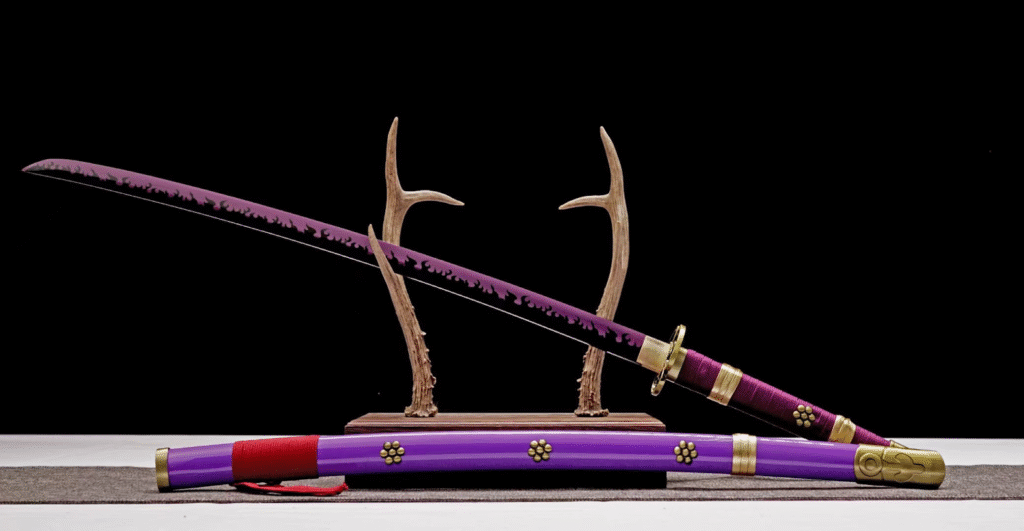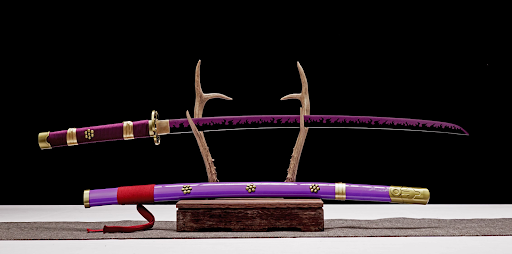This article will compare and contrast these two legendary blades. We will explore their design, combat applications, and the profound cultural legacies they carry. For any martial arts enthusiast, history buff, or collector, understanding the nuances between a katana and a double-edged sword reveals a deeper appreciation for the art of the blade.
Design and Construction: Form Follows Function
The most apparent differences between a Japanese sword and a European double-edged sword lie in their physical construction. These design choices are not arbitrary; they are the direct result of the materials available, the armor they were meant to defeat, and the combat styles they enabled.
The Blade: Curve vs. Straight
- Katana:The katana is famous for its gentle, graceful curve (sori). This curvature is not just for aesthetics; it is a natural result of the differential hardening process, where clay is applied unevenly to the blade before quenching. This process creates a very hard edge (the yakiba) and a softer, more resilient spine (the mune). The curve allows for more effective slashing cuts, enabling the blade to slice through a target with minimal resistance. The blade itself is single-edged, concentrating all its cutting power along one line.
- Double-Edged Sword:In contrast, the European longsword is typically straight and double-edged. This design makes it a more versatile weapon in certain scenarios. With two sharp edges, a warrior could cut effectively with both forehand and backhand swings without changing their grip or stance. The straight design, culminating in a sharp point, also makes it an excellent thrusting weapon, ideal for piercing the gaps in plate armor or penetrating chainmail.
Length, Weight, and Balance
The average samurai sword blade length is around 27-29 inches (70-75 cm). They are generally lighter than their European counterparts, designed for speed and precision. The balance point of a katana is typically further down the blade, which facilitates the powerful, drawing cuts central to Japanese swordsmanship.
European longswords vary more widely in size but are often longer and heavier. This added mass provided the momentum needed for powerful cuts against armored opponents. Their balance point is closer to the hilt, allowing for greater point control and maneuverability during complex thrusts and parries.
Handle (Tsuka) and Guard (Tsuba)
The katana features a long handle (tsuka) designed for a two-handed grip, providing leverage for swift, powerful cuts. It is traditionally wrapped in ray skin (samegawa) and then covered with a silk or cotton braid (tsuka-ito), ensuring a secure grip. The guard (tsuba) is typically a small, circular or squared disc, offering protection for the hands while remaining unobtrusive.
The double-edged sword also has a two-handed grip, but its defining feature is the complex crossguard. This guard is crucial for protecting the hands from an opponent’s blade sliding down their own. It also allows for advanced defensive techniques, such as trapping and controlling the opponent’s weapon.
Functionality and Combat Use
The distinct designs of these swords led to the development of unique martial arts and combat doctrines.

Cutting and Thrusting Techniques
Japanese swordsmanship, or kenjutsu, emphasizes fluid, circular movements and powerful, precise cuts. The primary technique involves a drawing slash that utilizes the blade’s curvature to slice cleanly through a target. While a katana can thrust, its design is optimized for cutting. A double edge katana is a rarer variation that attempts to blend styles, but the classic single-edged design remains the standard.
In contrast, European swordsmanship is a more versatile system that incorporates a balanced mix of cuts, thrusts, and pommel strikes. The straight, double-edged blade is equally adept at cleaving through unarmored targets and delivering precise stabs to exploit weaknesses in an opponent’s armor. The crossguard and pommel were also integrated into combat as secondary weapons for hooking, trapping, and striking.
Advantages in Different Scenarios
- The katanaexcels in unarmored or lightly armored combat. Its legendary sharpness, a product of master smiths like those producing Masamune swords, allowed a skilled samurai to end a duel with a single, perfect cut. Its speed and agility made it a formidable weapon in one-on-one encounters.
- The European longsword was a battlefield workhorse. Its robust construction and versatile design made it effective against a variety of opponents, from unarmored soldiers to fully-armored knights. The ability to thrust effectively was a critical advantage against the increasingly sophisticated plate armor of the late Middle Ages.
Historical and Cultural Significance
Beyond their use in combat, both swords are powerful cultural symbols that represent the ideals of the warriors who wielded them.
The samurai sword is more than a weapon; it is the embodiment of Bushido, the samurai code. It represents honor, loyalty, and precision. The creation of a Japanese sword was a sacred act, and the blade itself was considered to have a soul. Its legacy is deeply intertwined with the history of feudal Japan and the samurai class.
The European longsword symbolizes the knightly virtues of chivalry, justice, and martial prowess. It was the signature weapon of the medieval knight, a symbol of their status and duty to protect the realm. Its presence in art, literature, and ceremony underscores its importance in European history.
The Legacy in Modern Times
Today, both the katana and the European longsword continue to captivate the imagination. They are popular among collectors, historical reenactors, and martial arts practitioners. You can find many high-quality swords for sale that replicate these historic designs with stunning accuracy.
Their influence permeates popular culture, appearing in films, video games, and literature. The katana, in particular, has become a global icon of cool, representing the silent, deadly warrior. The double-edged sword remains the quintessential weapon of fantasy heroes, from Aragorn in The Lord of the Rings to Geralt of Rivia in The Witcher.
A Legacy Forged in Steel
While the katana and the double-edged sword were both born of fire and steel, they walked different paths. The samurai sword is a specialized instrument of deadly grace, a single-edged slicer perfected for the duel. The European longsword is a versatile tool of war, a double-edged blade built to cut, thrust, and overcome armor on the battlefield.
Neither sword is definitively “better” than the other; they are simply different, each a perfect solution to the challenges its wielder faced. Their enduring legacies are a testament to the master craftsmen who forged them and the legendary warriors who carried them into history. They remain powerful symbols of tradition, skill, and the timeless allure of a well-made blade.







